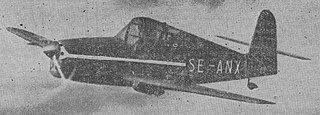
The Fletcher FU-24 is an agricultural aircraft made in New Zealand. One of the first aircraft designed for aerial topdressing, the Fletcher has also been used for other aerial applications as a utility aircraft, and for sky diving.

The Alpha Aviation Alpha 2000 is a two-seat, all-metal training and general aviation aircraft, designed by Chris Heintz and built in Hamilton, New Zealand. It continues the successful French Apex Aircraft's Robin R2000 series acquired upon Apex's purchase of the Avions Robin company.

The PL-11 Airtruck is a New Zealand agricultural aircraft.

The PZL.44 Wicher (gale) was a prototype of 14-seat, twin-engine Polish airliner, built in the Państwowe Zakłady Lotnicze (PZL) in 1938. It was to compete with the DC-2 and Lockheed Super Electra.

The Auster J/5 Autocar was a late 1940s British single-engined four-seat high-wing touring monoplane built by Auster Aircraft Limited at Rearsby, Leicestershire.

The PZL-105 Flaming (flamingo) is a Polish short-takeoff-and-landing (STOL) utility aircraft designed by PZL "Warszawa-Okęcie". It remained a prototype.

The Avro 627 Mailplane was a British biplane developed in 1931 by Avro from the Avro Antelope bomber as a mail plane for use in Canada. Only one was built which ended up being used as a test bed.

The PZL-102 Kos (blackbird) is a Polish two-seat touring and training monoplane designed and built by PZL.
The White Lightning WLAC-1 is an American four-seat single-engined monoplane designed for amateur construction by Nick Jones and sold as kits by the White Lighting Aircraft Corporation of South Carolina.
The Bréguet 790 Nautilus was a prototype French three-seat coastal patrol flying-boat designed and built by Bréguet Aviation to meet a requirement from the French navy.

The PWS-4 was a prototype Polish sports aircraft, developed in 1928 by Podlaska Wytwórnia Samolotów.

The Skandinaviska Aero BHT-1 Beauty is a 1940s Swedish single-seat light monoplane designed by E. Bratt, K.E. Hilfing and B.Törnblom and built by Skandinaviska Aero of Stockholm.
The Buchanan BAC-204 Ozzie Mozzie is an Australian two-seat light aircraft designed and built by Buchanan Aircraft Corporation of Queensland for certification to meet JAR-VLA.

The Powell P-70 Acey Deucy is an American two-seat parasol wing monoplane designed and built by John C. Powell for amateur construction.
The Richard 150 Commuter is an American two-seat cabin monoplane designed and built by The C.H. Richard Company of Lancaster, California to be sold in kit form or as plans for amateur construction.
The Bristol BX-200 is an American two-seat cross-country homebuilt monoplane designed and built by Uriel Bristol for amateur construction from plans or kits.
The EADS PZL PZL-112 Junior is a Polish single engine, two-seat trainer built by PZL Warszawa-Okecie.

The Partenair Mystere is a Canadian two-seat, pusher configuration monoplane that was designed by Partenair Design of Saint-Jean-sur-Richelieu, Quebec and intended for amateur construction from kits.

The Turbay T-3A was an Argentine twin-engined seven-seater light transport of the 1960s. A single example was built, but no production followed.

The Technoavia SP-95 is a Russian aerobatic aircraft, a production version of the earlier SP-91 Slava. The design is similar to the Sukhoi Su-26 family as it was designed by the same designer. It is an aerobatic competition aircraft and can be changed from single-seat to two-seat configuration. The SP-95 is a metal construction low-wing cantilever monoplane with a conventional landing gear with a tail-wheel. It is powered by a Vedeneyev M14P radial piston engine.














